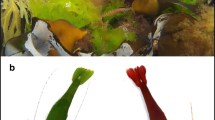Abstract
MANY readers of Nature have taken part in a co-operative study of an apparently new feeding habit1, about which there are now some fairly clear-cut conclusions. Two or more greenfinches (Chloris chloris L.) will fly some distance to the garden shrub Daphne mezereum L., usually in June, to devour every one of its hundreds of large seeds in a strikingly avid and fearless manner. Green and immature fruits are preferred, when the stone of these drupe fruits is not quite so hard. Once a garden has been visited in this way, there is a 95 per cent chance that it will continue to be visited regularly and without intermission.
This is a preview of subscription content, access via your institution
Access options
Subscribe to this journal
Receive 51 print issues and online access
$199.00 per year
only $3.90 per issue
Buy this article
- Purchase on Springer Link
- Instant access to full article PDF
Prices may be subject to local taxes which are calculated during checkout
Similar content being viewed by others
References
Pettersson, M. L. R., Nature, 177, 709 (1956).
Boyd, A. W., Brit. Birds, 24, 329 (1930). Witherby, H. F., et al., “The Handbook of British Birds” (London, 1940).
Fisher, J., and Hinde, R. A., Brit. Birds, 42, 347 (1949).
Sutherland, E., Otago Daily Times (Feb. 6, 1958).
Author information
Authors and Affiliations
Rights and permissions
About this article
Cite this article
PETTERSSON, M. Diffusion of a New Habit among Greenfinches. Nature 184, 649–650 (1959). https://doi.org/10.1038/184649a0
Issue Date:
DOI: https://doi.org/10.1038/184649a0
This article is cited by
-
Citizens, science and bird conservation
Journal of Ornithology (2007)
Comments
By submitting a comment you agree to abide by our Terms and Community Guidelines. If you find something abusive or that does not comply with our terms or guidelines please flag it as inappropriate.



